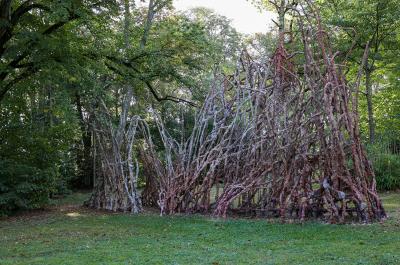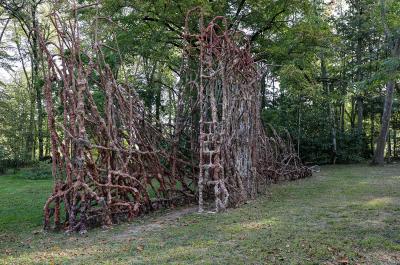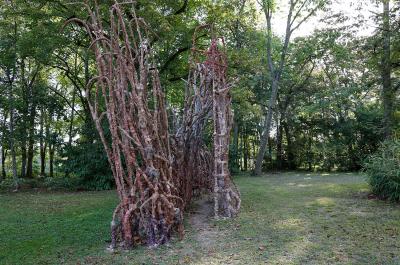10. Lionel Sabatté
"Chemins croisés"

Lionel Sabatté’s body of work is imbued with a strange beauty, the kind that arises from metamorphoses of matter. Sometimes alchemist playing with the reaction of metals, sometimes demiurge creating wolves out of magmas of dust, the artist creates with his hands, patiently endowing his pieces with complements of soul and breath. Sculptures, paintings, oxidations on metal plates, installations and drawings bear unique witness to an original force that has crossed the ages since the origin of the universe up until today’s meteorological rampages.
Everything that lives is of interest to the artist. Vegetable, animal, human, all known life forms, and even those yet to be discovered, are at the heart of his research. As evidence of this, he busies himself with a whole range of improbable collections (claws, dead skins, dust, ash...), makes a habit of recovering natural features (tree stumps, trees, and plants of various kinds), oxidises metal, combines cement with reinforcing steel... Lionel Sabatté’s single obsession is to make matter speak, know how to restore even the slightest energy, so as to renew our apprehension of our immediate environment and the world as a whole.
“The question of the environment necessarily arises when you’re interested in living things, as it provides them with the very condition for their existence. There’s also the fundamental question of the emergence of life. How so-called inanimate matter became something that can be born, reproduce, die and disappear – the three aspects of the definition of life in biology. Living things are inherently extremely fragile and depend on environmental conditions. I should like to know where to draw the line between things we define as living and those that are not, because in reality everything changes, everything is connected, and when you’re having to cope with ecological disasters, you can see the extent to which we’re all interconnected,” Lionel Sabatté explained to Aurélie Voltz, Director of MAMC+ in Saint-Étienne Metropolis, during an interview on the occasion of the Éclosion exhibition held by the institution in 2021.
In his studio, the artist stores and creates. He goes from one surprise to the next, orchestrating his practice while leaving room for expression by materials he regards as archives bearing witness to an “us” that is both societal and organic. Sometimes he fashions a world peopled with creatures, often animal or anthropomorphic, protagonists in a new mythology; sometimes he shapes others using oxidation processes, whose colours reveal the depths of passing time.
Lionel Sabatté often creates in situ, starting up a dialogue with the site he has taken over and seeking to establish the ideal proportions in its regard. Passageway or refuge, the new work that Lionel Sabatté designed for Chaumont-sur-Loire is a place of transition, becoming part of the landscape like a cave, undergrowth, a chrysalis. Constructed of cement and vegetable fibre applied to reinforcing steel, this work acts as a passageway from one world to another, creating porosity between reality and fairytale. Who built it? Who lives in it? Between ruin and dwelling place, it emerges from the earth and works powerfully on our imaginations.
“I like the idea of ruins under construction, the two slopes becoming one. What I look for in concrete is its rubble side, as cement is really dehydrated rock that’s been powdered and can then be made into a paste for building walls. When these are finally blown up, they become rubble once again, and eventually pebbles and rocks. When I was a child, I had a hard time telling the difference between pebbles and rubble. When I finally understood their respective origins, I was much troubled by this endless cycle”, he also explained in 2021.
Although he is prone to vertigo, Lionel Sabatté has no hesitation in raising his works several metres above the ground, for to risk disequilibrium is above all to promote movement and consequently life.
BIOGRAPHICAL NOTES

Born in Toulouse in 1975, Lionel Sabatté is a painter, sculptor and draughtsman. Since graduating from Paris National Higher School of Fine Arts in 2003, he has been carrying out exemplary artistic work whose central themes are transformation of matter, the passage of time, and representations of living things, vegetable, animal and human alike. His research gives rise to works that are poetic, sensitive and troubling all in one, part of an overall reflection on the world and the human condition. What is humankind’s place in the great cycle of life? That’s the question that runs through his whole body of work.
By borrowing from the vocabulary of the natural sciences and the imagery of parietal art, the artist imbues his creations – paintings, drawings, sculptures and engravings – with an organic, telluric dimension, very possibly connected with his first youthful visions on Reunion Island’s volcanic shores. Letting himself be guided by the energy within the matter, Lionel Sabatté has based his work on reuse of recovered materials.
The artist devotes a good deal of time amassing collections of materials that bear the traces of lives once lived: dust, ash, coal, dead skins, tree stumps, and so on... Components that he combines in unexpected ways to create pieces of “troubling strangeness”, breathing life into a hybrid bestiary in which marine creatures mingle with birds, bears, wolves and unicorns. Like his taxidermist grandfather before him, the artist sculpts and models in order to provide these confabulated beings with new skins.
Whether he expresses himself in painting, sculpture or drawing, Lionel Sabatté weaves links between all his works, giving thought to human beings’ relationship with their environment, a concern that has not escaped the notice of a good many institutions. Hence, in 2011, the Paris Museum of Natural History chose to present Meute de Loups, sculptures created out of dust, making the installation emblematic of the many questions raised on environmental issues. The initiative was continued in 2014 by the Paris Aquarium, which asked the artist to draw the public’s attention to the overexploitation of marine resources. This second exhibition was followed by a third in the city of La Rochelle, this time on the theme of water and natural resources. Recently, Lionel Sabatté was invited to the Museum of Hunting and Nature. La sélection de parentèle was a reflection on living things and evolution.
Recent works, such as the imposing oxidised bronze birds presented in Lyon in 2019 for the exhibition entitled Qui sait combien de fleurs ont dû tomber and in Toulouse for the Lionel Sabatté: sculptures exhibition, and La Paroi des profondeurs, an installation in cement, pigments, reinforcing steel and fibre, presented at MAMC+ in Saint-Etienne in 2021 (Éclosion exhibition), have led him to redefine his relationship with sculpture and continuously reinvent his artistic practice.
Lionel Sabatté is represented by Galerie Ceysson & Bénétière.


